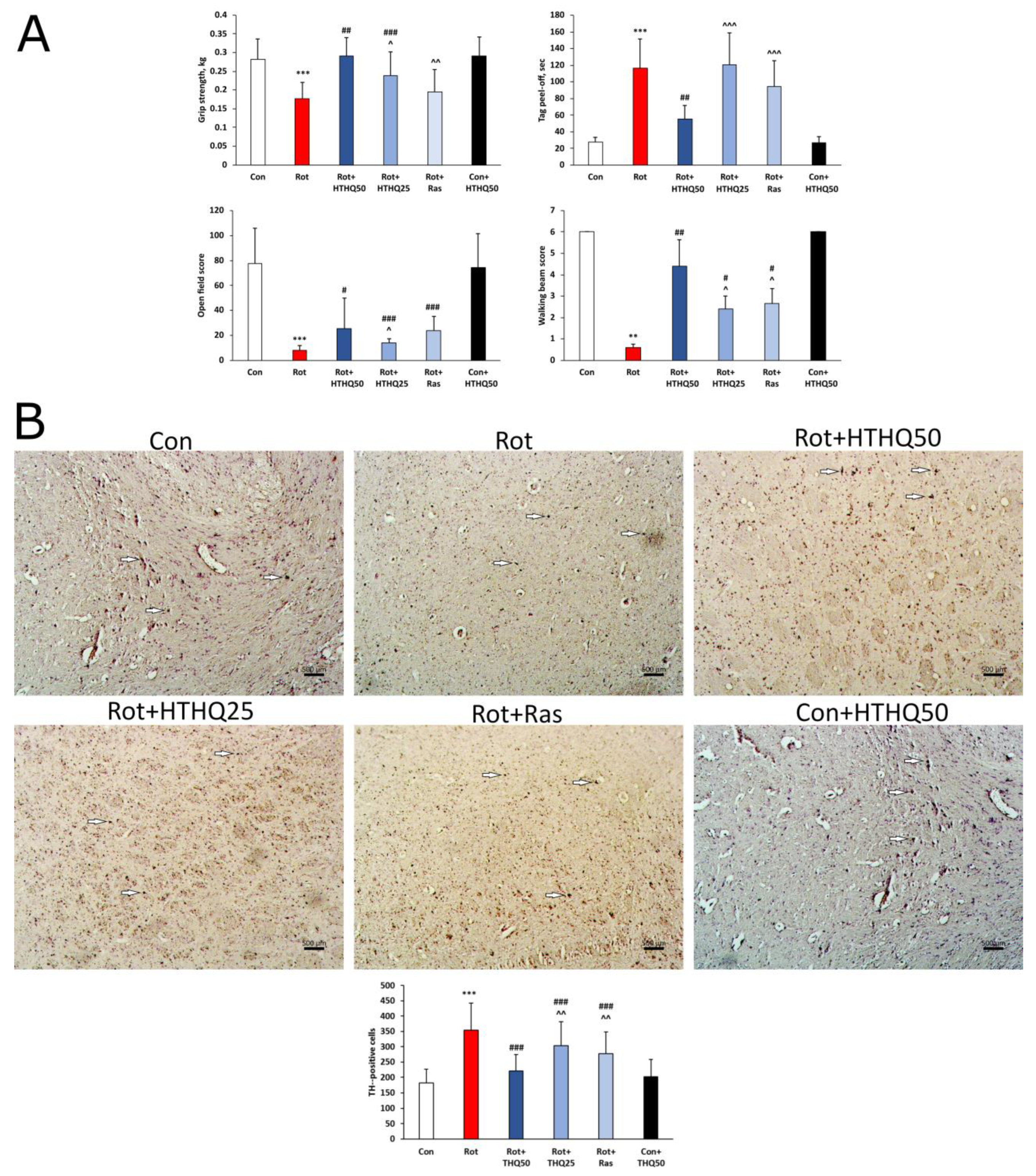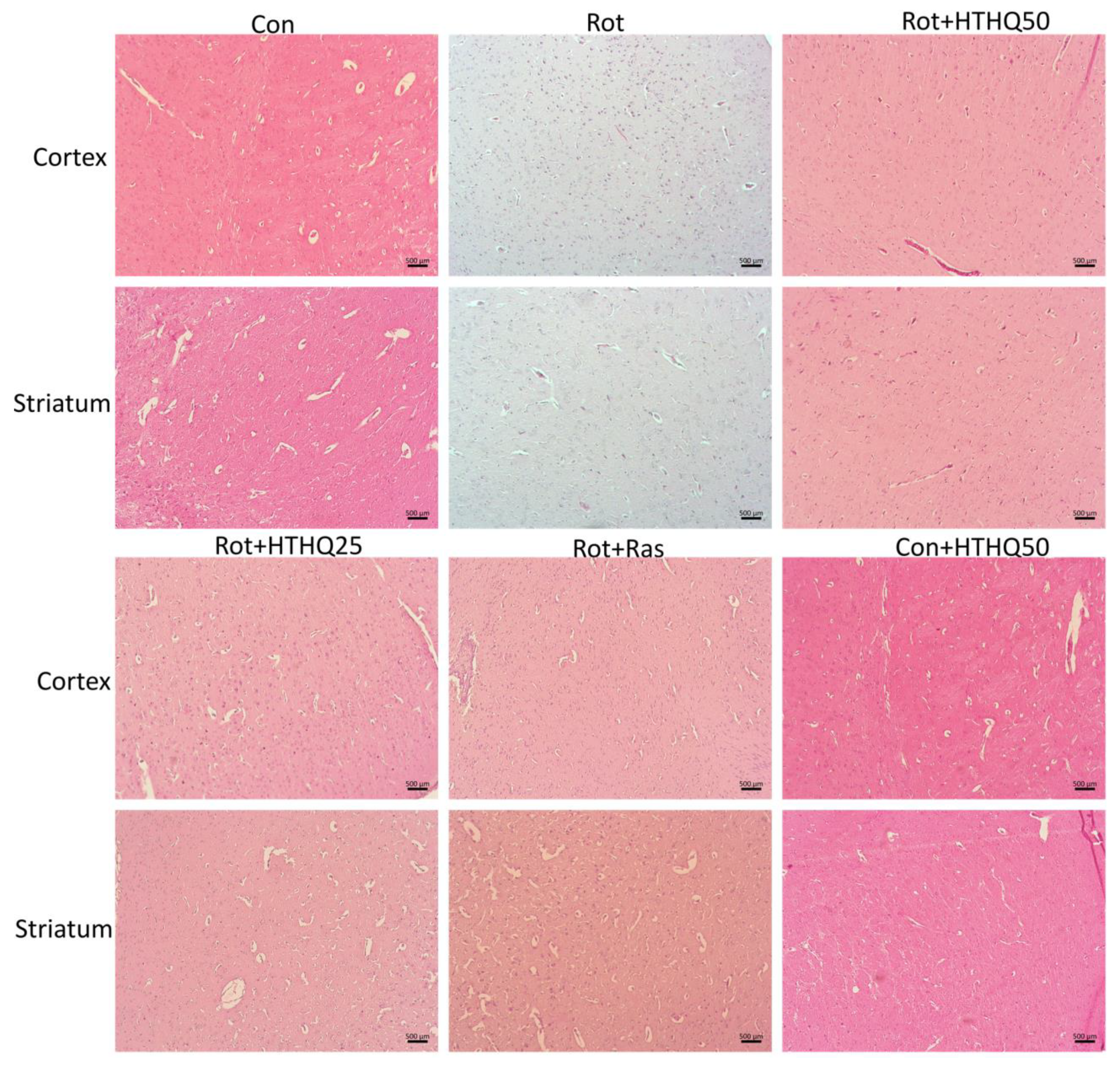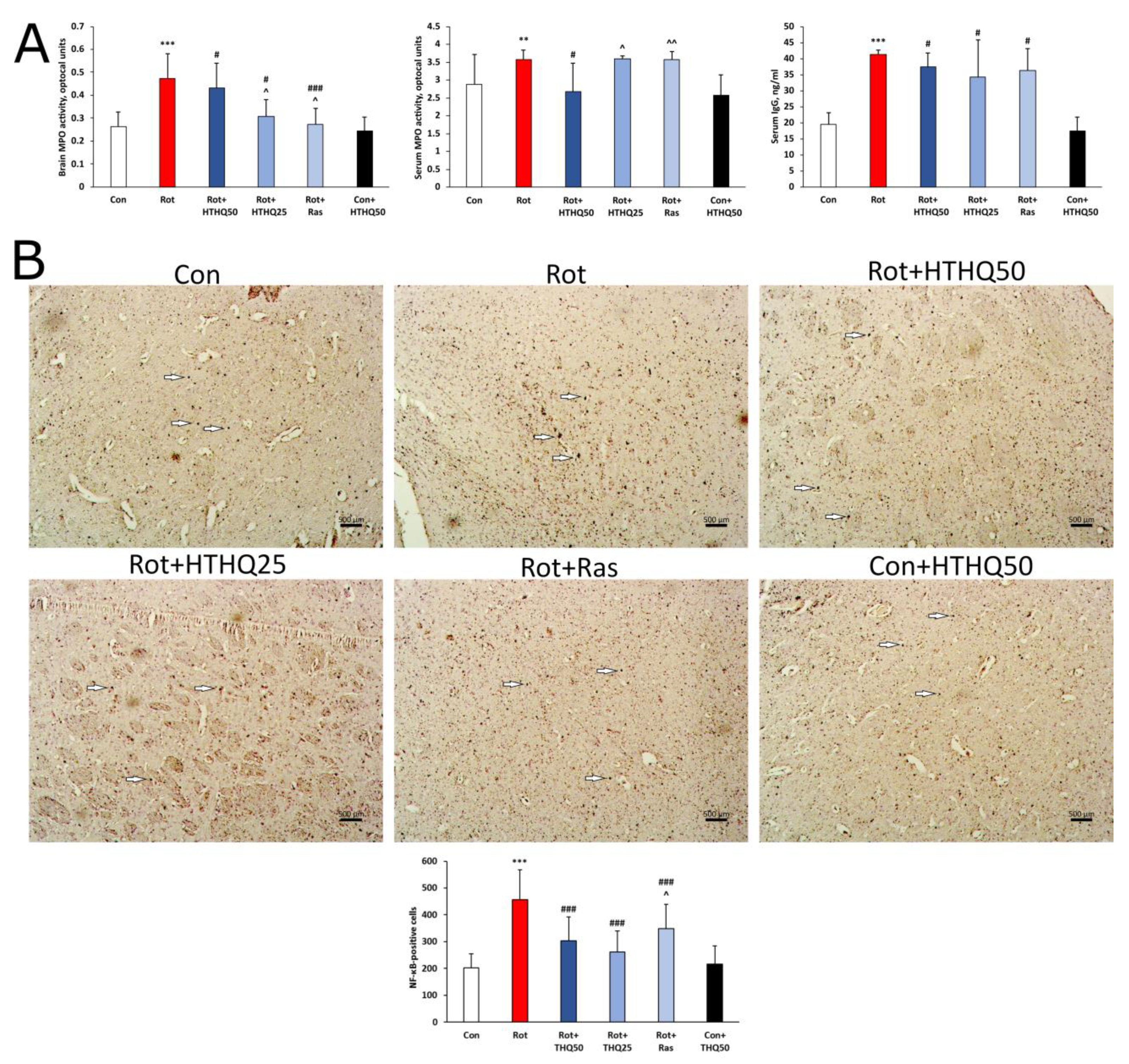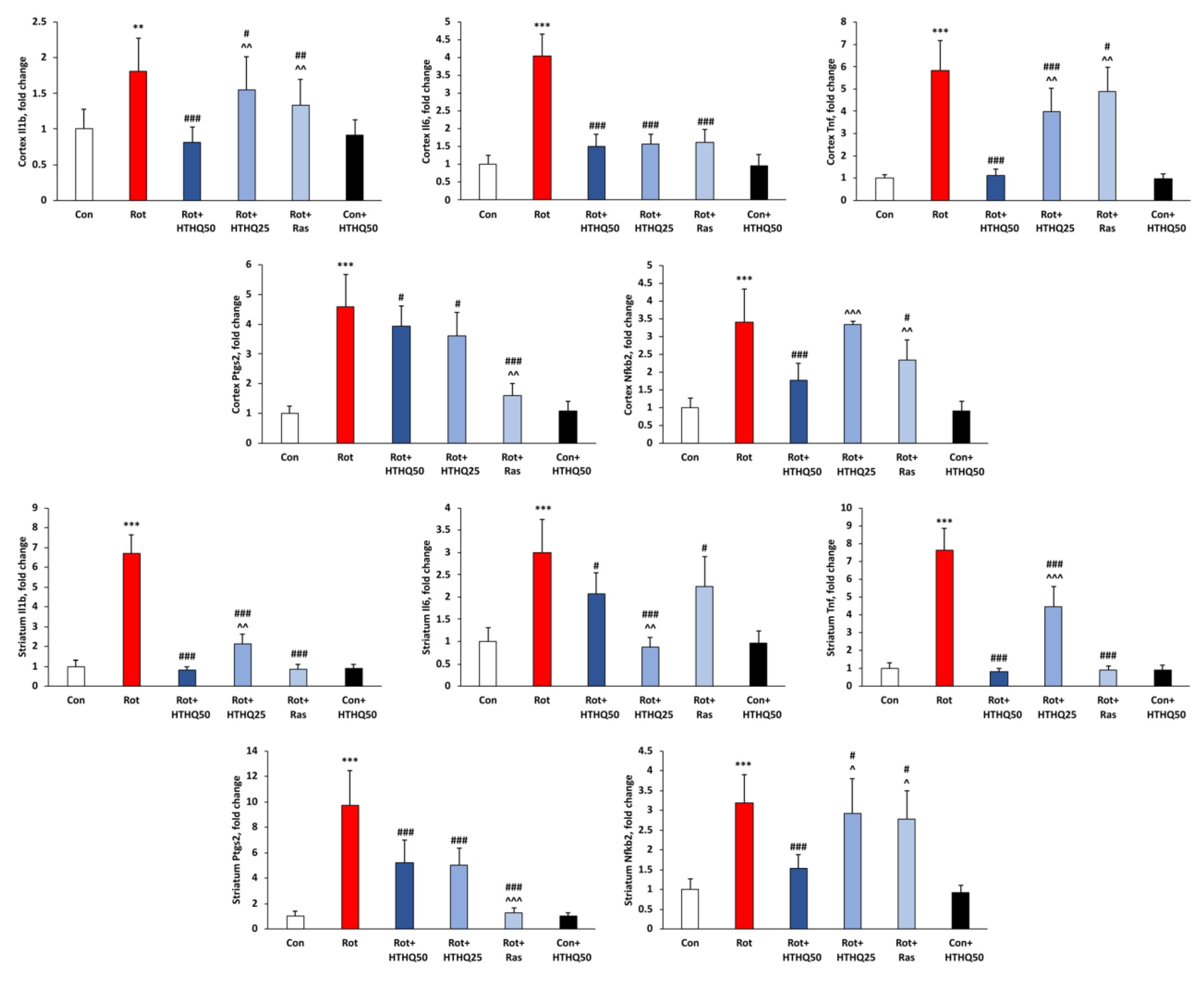6-Hydroxy-2,2,4-trimethyl-1,2,3,4-tetrahydroquinoline Alleviates Oxidative Stress and NF-κB-Mediated Inflammation in Rats with Experimental Parkinson’s Disease
Abstract
:1. Introduction
2. Materials and Methods
2.1. Synthesis of HTHQ and Analysis of its Ability to Penetrate the BBB
2.2. Animal Studies and Experimental Design
2.3. Motor Coordination Tests
- (1)
- Holding the rat by the tail, it was given to hook its front legs to the bracket of electronic scales. The scales were pulled away, and the maximum value of the index was recorded [23].
- (2)
- The animal was placed in a transparent cage, and a piece of sticky paper was placed on its head. The time it took the rat to perceive the stimulus and remove the paper from its head was recorded [24].
- (3)
- The walking beam test. The rat was allowed to cross a wooden beam at the end of what was a dark box. The scores were as follows: 0 = rat fell; 1 = rat was unable to cross the beam but remained seated across the beam; 2 = rat fell during the walk; 3 = rat was able to cross the beam, but hind limbs did not contribute to forward movement; 4 = rat crossed the beam with limb slippage more than 3 times; 5 = rat crossed the beam with slippage between 1 and 3 times; and 6 = rat crossed the beam without foot slippage [25]. All tests were carried out in triplicate, and the mean value of indicators was taken.
- (4)
- One rat was placed in the center of the arena and left to explore for 5 min in a darkened and quiet room. We recorded the number of squares crossed by the rat (with all four paws crossing the line, each crossing of the line was scored as 1 point), the rearing behaviors (each rearing was scored as 1 point), the grooming behavior (each grooming was scored as 1 point), the feces (each piece of feces was scored as 1 point; urine was also scored as 1 point) and movement latency (time to exit the first square) [26].
2.4. Histological Examination
2.5. Immunohistochemistry
2.6. ELISA
2.7. Biochemical Analysis
2.8. RNA Isolation, Reverse Transcription, and Quantitative PCR
2.9. Statistical Analysis
3. Results
3.1. HTHQ Improves Motor-Coordination Scores and Restores TH Levels in the Brains of Rats with PD
3.2. HTHQ Reduces the Severity of Histopathological Changes in Brain Tissues of Rats with PD
3.3. HTHQ Reduces the Level of Oxidative Stress in PD in Rats
3.4. HTHQ Decreases the Intensity of Inflammatory Response and NF-κB Expression in the Brains of Rats with PD
4. Discussion
Author Contributions
Funding
Institutional Review Board Statement
Informed Consent Statement
Data Availability Statement
Conflicts of Interest
References
- Bloem, B.R.; Okun, M.S.; Klein, C. Parkinson’s disease. Lancet 2021, 397, 2284–2303. [Google Scholar] [CrossRef] [PubMed]
- Ball, N.; Teo, W.-P.; Chandra, S.; Chapman, J. Parkinson’s Disease and the Environment. Front. Neurol. 2019, 10, 218. [Google Scholar] [CrossRef]
- Armstrong, M.J.; Okun, M.S. Diagnosis and Treatment of Parkinson Disease: A Review. JAMA 2020, 323, 548–560. [Google Scholar] [CrossRef] [PubMed]
- Dorszewska, J.; Kowalska, M.; Prendecki, M.; Piekut, T.; Kozłowska, J.; Kozubski, W. Oxidative stress factors in Parkinson’s disease. Neural Regen. Res. 2021, 16, 1383–1391. [Google Scholar] [CrossRef] [PubMed]
- Percario, S.; Barbosa, A.S.; Pompeu Varela, E.L.; Quadros Gomes, A.R.; Souza Ferreira, M.E.; Araújo Moreira, T.N.; Dolabela, M.F. Oxidative Stress in Parkinson’s Disease: Potential Benefits of Antioxidant Supplementation. Oxidative Med. Cell. Longev. 2020, 2020, 2360872. [Google Scholar] [CrossRef] [PubMed]
- Pajares, M.; Rojo, A.I.; Manda, G.; Boscá, L.; Cuadrado, A. Inflammation in Parkinson’s Disease: Mechanisms and Therapeutic Implications. Cells 2020, 9, 1687. [Google Scholar] [CrossRef] [PubMed]
- Marogianni, C.; Sokratous, M.; Dardiotis, E.; Hadjigeorgiou, G.M.; Bogdanos, D.; Xiromerisiou, G. Neurodegeneration and Inflammation—An Interesting Interplay in Parkinson’s Disease. Int. J. Mol. Sci. 2020, 21, 8421. [Google Scholar] [CrossRef]
- Singh, S.S.; Rai, S.N.; Birla, H.; Zahra, W.; Singh, R.A.; Singh, S.P. NF-κB-Mediated Neuroinflammation in Parkinson’s Disease and Potential Therapeutic Effect of Polyphenols. Neurotox. Res. 2020, 37, 491–507. [Google Scholar] [CrossRef]
- Lingappan, K. NF-κB in oxidative stress. Curr. Opin. Toxicol. 2018, 7, 81–86. [Google Scholar] [CrossRef]
- Torres-Ortega, P.V.; Saludas, L.; Hanafy, A.S.; Garbayo, E.; Blanco-Prieto, M.J. Micro- and nanotechnology approaches to improve Parkinson’s disease therapy. J. Control. Release 2019, 295, 201–213. [Google Scholar] [CrossRef]
- El-Saghier, A.M.; El-Naggar, M.; Hussein, A.H.M.; El-Adasy, A.B.A.; Olish, M.; Abdelmonsef, A.H. Eco-Friendly Synthesis, Biological Evaluation, and In Silico Molecular Docking Approach of Some New Quinoline Derivatives as Potential Antioxidant and Antibacterial Agents. Front. Chem. 2021, 9, 679967. [Google Scholar] [CrossRef] [PubMed]
- Wen, X.; Wang, S.B.; Liu, D.C.; Gong, G.H.; Quan, Z.S. Synthesis and evaluation of the anti-inflammatory activity of quinoline derivatives. Med. Chem. Res. 2015, 24, 2591–2603. [Google Scholar] [CrossRef]
- Kumar, S.; Bawa, S.; Gupta, H. Biological Activities of Quinoline Derivatives. Mini-Rev. Med. Chem. 2009, 9, 1648–1654. [Google Scholar] [CrossRef] [PubMed]
- Orhan Puskullu, M.; Tekiner, B.; Suzen, S. Recent Studies of Antioxidant Quinoline Derivatives. Mini Rev. Med. Chem. 2013, 13, 365–372. [Google Scholar] [PubMed]
- Iskusnykh, I.Y.; Kryl’skii, E.D.; Brazhnikova, D.A.; Popova, T.N.; Shikhaliev, K.S.; Shulgin, K.K.; Matasova, L.V.; Popov, S.S.; Zhaglin, D.A.; Zakharova, A.A.; et al. Novel Antioxidant, Deethylated Ethoxyquin, Protects against Carbon Tetrachloride Induced Hepatotoxicity in Rats by Inhibiting NLRP3 Inflammasome Activation and Apoptosis. Antioxidants 2021, 10, 122. [Google Scholar] [CrossRef]
- Kryl’skii, E.D.; Chupandina, E.E.; Popova, T.N.; Shikhaliev, K.S.; Mittova, V.O.; Popov, S.S.; Verevkin, A.N.; Filin, A.A. Neuroprotective effect of 6-hydroxy-2,2,4-trimethyl-1,2-dihydroquinoline mediated via regulation of antioxidant system and inhibition of inflammation and apoptosis in a rat model of cerebral ischemia/reperfusion. Biochimie 2021, 186, 130–146. [Google Scholar] [CrossRef]
- Iyer, M.; Mishra, R.; Han, Y.; Hopfinger, A.J. Predicting Blood–Brain Barrier Partitioning of Organic Molecules Using Membrane–Interaction QSAR Analysis. Pharm. Res. 2002, 19, 1611–1621. [Google Scholar] [CrossRef]
- Ivanov, Y.A.; Zaichenko, N.L.; Rykov, S.V.; Grinberg, O.Y.; Dubinskii, A.A.; Pirozhkov, S.D.; Rozantsev, E.G.; Pokrovskaya, I.E.; Shapiro, A.B. The synthesis of hydroxy, acyloxy, oxo, N-oxides oxo and morpholino derivatives of hydrogenated quinolines and the study of their radical analogs by ESR. Bull. Acad. Sci. USSR Div. Chem. Sci. 1979, 28, 1661–1668. [Google Scholar] [CrossRef]
- Rybakov, V.B.; Alekseev, N.V.; Sheludyakov, V.D.; Ivanov, Y.A.; Frolov, A.Y.; Aslanov, L.A. 6-Ethoxy-1,2,3,4-tetrahydro-2,2,4-trimethylquinoline. Acta Crystallogr. Sect. E Struct. Rep. Online 2004, 60, o1145–o1146. [Google Scholar] [CrossRef]
- Liu, H.B.; Wang, L.; Su, W.W.; Xie, X.Q. ALzPlatform: An Alzheimer’s Disease Domain-Specific Chemogenomics Knowledgebase for Polypharmacology and Target Identification Research. J. Comput. Inf. Model. 2014, 54, 1050–1060. [Google Scholar] [CrossRef]
- Ablat, N.; Lv, D.; Ren, R.; Xiaokaiti, Y.; Ma, X.; Zhao, X.; Sun, Y.; Lei, H.; Xu, J.; Ma, Y.; et al. Neuroprotective Effects of a Standardized Flavonoid Extract from Safflower against a Rotenone-Induced Rat Model of Parkinson’s Disease. Molecules 2016, 21, 1107. [Google Scholar] [CrossRef]
- Hayes, M.T. Parkinson’s Disease and Parkinsonism. Am. J. Med. 2019, 132, 802–807. [Google Scholar] [CrossRef]
- Sharma, S.; Kumar, P.; Deshmukh, R. Neuroprotective potential of spermidine against rotenone induced Parkinson’s disease in rats. Neurochem. Int. 2018, 116, 104–111. [Google Scholar] [CrossRef] [PubMed]
- Park, H.J.; Lee, P.H.; Bang, O.Y.; Lee, G.; Ahn, Y.H. Mesenchymal stem cells therapy exerts neuroprotection in a progressive animal model of Parkinson’s disease. J. Neurochem. 2008, 107, 141–151. [Google Scholar] [CrossRef]
- Zhu, W.; Chi, N.; Zou, P.; Chen, H.; Tang, G.; Zhao, W. Effect of docosahexaenoic acid on traumatic brain injury in rats. Exp. Ther. Med. 2017, 14, 4411–4416. [Google Scholar] [CrossRef]
- Hu, C.; Luo, Y.; Wang, H.; Kuang, S.; Liang, G.; Yang, Y.; Mai, S.; Yang, J. Re-evaluation of the interrelationships among the behavioral tests in rats exposed to chronic unpredictable mild stress. PLoS ONE 2017, 12, e0185129. [Google Scholar] [CrossRef] [PubMed]
- Recknagel, R.O.; Ghoshal, A.K. Lipoperoxidation of rat liver microsomal lipids induced by carbon tetrachloride. Nature 1966, 210, 1162–1163. [Google Scholar] [CrossRef] [PubMed]
- Reznick, A.Z.; Packer, L. Oxidative damage to proteins: Spectrophotometric method for carbonyl assay. Meth. Enzymol. 1994, 233, 357–363. [Google Scholar]
- Pulli, B.; Ali, M.; Forghani, R.; Schob, S.; Hsieh, K.L.; Wojtkiewicz, G.; Linnoila, J.J.; Chen, J.W. Measuring myeloperoxidase activity in biological samples. PLoS ONE 2013, 8, e67976. [Google Scholar] [CrossRef]
- Azimullah, S.; Jayaraj, R.L.; Meeran, M.F.N.; Jalal, F.Y.; Adem, A.; Ojha, S.; Beiram, R. Myrcene Salvages Rotenone-Induced Loss of Dopaminergic Neurons by Inhibiting Oxidative Stress, Inflammation, Apoptosis, and Autophagy. Molecules 2023, 28, 685. [Google Scholar] [CrossRef]
- Pan, X.; Liu, X.; Zhao, H.; Wu, B.; Liu, G. Antioxidant, anti-inflammatory and neuroprotective effect of kaempferol on rotenone-induced Parkinson’s disease model of rats and SH-S5Y5 cells by preventing loss of tyrosine hydroxylase. J. Funct. Foods 2020, 74, 104140. [Google Scholar] [CrossRef]
- Naoi, M.; Maruyama, W.; Shamoto-Nagai, M. Rasagiline and selegiline modulate mitochondrial homeostasis, intervene apoptosis system and mitigate α-synuclein cytotoxicity in disease-modifying therapy for Parkinson’s disease. J. Neural Transm. 2020, 127, 131–147. [Google Scholar] [CrossRef] [PubMed]
- Sharma, A.; Weber, D.; Raupbach, J.; Dakal, T.C.; Fließbach, K.; Ramirez, A.; Grune, T.; Wüllner, U. Advanced glycation end products and protein carbonyl levels in plasma reveal sex-specific differences in Parkinson’s and Alzheimer’s disease. Redox Biol. 2020, 34, 101546. [Google Scholar] [CrossRef]
- Nikam, S.; Nikam, P.; Ahaley, S.K.; Sontakke, A.V. Oxidative stress in Parkinson’s disease. Indian J. Clin. Biochem. 2009, 24, 98–101. [Google Scholar] [CrossRef]
- Verma, R.; Nehru, B. Effect of centrophenoxine against rotenone-induced oxidative stress in an animal model of Parkinson’s disease. Neurochem. Int. 2009, 55, 369–375. [Google Scholar] [CrossRef] [PubMed]
- Naik, H.R.; Naik, H.S.; Naik, T.R.; Naika, H.R.; Gouthamchandra, K.; Mahmood, R.; Ahamed, B.M. Synthesis of novel benzo[h]quinolines: Wound healing, antibacterial, DNA binding and in vitro antioxidant activity. Eur. J. Med. Chem. 2009, 44, 981–989. [Google Scholar] [CrossRef] [PubMed]
- Wilhelm, E.A.; Ferreira, A.T.; Pinz, M.P.; Reis, A.S.D.; Vogt, A.G.; Stein, A.L.; Zeni, G.; Luchese, C. Antioxidant effect of quinoline derivatives containing or not selenium: Relationship with antinociceptive action quinolines are antioxidant and antinociceptive. Acad. Bras. Cienc. 2017, 89, 457–467. [Google Scholar] [CrossRef]
- Fernández-Espejo, E.; Rodríguez de Fonseca, F.; Gavito, A.L.; Córdoba-Fernández, A.; Chacón, J.; Martín de Pablos, Á. Myeloperoxidase and Advanced Oxidation Protein Products in the Cerebrospinal Fluid in Women and Men with Parkinson’s Disease. Antioxidants 2022, 11, 1088. [Google Scholar] [CrossRef] [PubMed]
- Papuć, E.; Kurzepa, J.; Kurys-Denis, E.; Grabarska, A.; Krupski, W.; Rejdak, K. Humoral response against glial derived antigens in Parkinson’s disease. Neurosci. Lett. 2014, 566, 77–81. [Google Scholar] [CrossRef] [PubMed]
- Dolatshahi, M.; Ranjbar Hameghavandi, M.H.; Sabahi, M.; Rostamkhani, S. Nuclear factor-kappa B (NF-κB) in pathophysiology of Parkinson disease: Diverse patterns and mechanisms contributing to neurodegeneration. Eur. J. Neurosci. 2021, 54, 4101–4123. [Google Scholar] [CrossRef] [PubMed]
- Teismann, P. COX-2 in the neurodegenerative process of Parkinson’s disease. BioFactors 2012, 38, 395–397. [Google Scholar] [CrossRef] [PubMed]
- Mukherjee, S.; Pal, M. Medicinal Chemistry of Quinolines as Emerging Anti-inflammatory Agents. Curr. Med. Chem. 2013, 20, 4386–4410. [Google Scholar] [CrossRef] [PubMed]
- Mukherjee, S.; Pal, M. Quinolines: A new hope against inflammation. Drug Discov. Today 2013, 18, 389–398. [Google Scholar] [CrossRef] [PubMed]
- Gupta, S.K.; Mishra, A. Synthesis, Characterization & Screening for Anti-Inflammatory & Analgesic Activity of Quinoline Derivatives Bearing Azetidinones Scaffolds. Anti-Inflamm. Anti-Allergy Agents Med. Chem. 2016, 15, 31–43. [Google Scholar]






| Name | Sequence |
|---|---|
| Nfkb2 | F: 5’- GAATTCAGCCCCTCCATTG-3’ |
| Nfkb2 | R: 5’- CTGAAGCCTCGCTGTTTAGG-3’ |
| Il1b | F: 5’-TGTGATGAAAGACGGCACAC -3’ |
| Il1b | R: 5’-CTTCTTCTTTGGGTATTGTTTGG-3’ |
| Il6 | F: 5’-CCTGGAGTTTGTGAAGAACAACT-3’ |
| Il6 | R: 5’-GGAAGTTGGGGTAGGAAGGA-3’ |
| Tnf | F: 5’-TCTGTGCCTCAGCCTCTTCT-3’ |
| Tnf | R: 5’-GGCCATGGAACTGATGAGA-3’ |
| Ptgs2 | F: 5’-TACACCAGGGCCCTTCCT-3’ |
| Ptgs2 | R: 5’-TCCAGAACTTCTTTTGAATCAGG-3’ |
| Gapdh | F: 5’-CCCTCAAGATTGTCAGCAATG-3’ |
| Gapdh | R: 5’-AGTTGTCATGGATGACCTTGG-3’ |
| Actb | F: 5’-CCCGCGAGTACAACCTTCT-3’ |
| Actb | R: 5’-CGTCATCCATGGCGAACT-3’ |
Disclaimer/Publisher’s Note: The statements, opinions and data contained in all publications are solely those of the individual author(s) and contributor(s) and not of MDPI and/or the editor(s). MDPI and/or the editor(s) disclaim responsibility for any injury to people or property resulting from any ideas, methods, instructions or products referred to in the content. |
© 2023 by the authors. Licensee MDPI, Basel, Switzerland. This article is an open access article distributed under the terms and conditions of the Creative Commons Attribution (CC BY) license (https://creativecommons.org/licenses/by/4.0/).
Share and Cite
Kryl’skii, E.D.; Razuvaev, G.A.; Popova, T.N.; Medvedeva, S.M.; Shikhaliev, K.S. 6-Hydroxy-2,2,4-trimethyl-1,2,3,4-tetrahydroquinoline Alleviates Oxidative Stress and NF-κB-Mediated Inflammation in Rats with Experimental Parkinson’s Disease. Curr. Issues Mol. Biol. 2023, 45, 7653-7667. https://doi.org/10.3390/cimb45090483
Kryl’skii ED, Razuvaev GA, Popova TN, Medvedeva SM, Shikhaliev KS. 6-Hydroxy-2,2,4-trimethyl-1,2,3,4-tetrahydroquinoline Alleviates Oxidative Stress and NF-κB-Mediated Inflammation in Rats with Experimental Parkinson’s Disease. Current Issues in Molecular Biology. 2023; 45(9):7653-7667. https://doi.org/10.3390/cimb45090483
Chicago/Turabian StyleKryl’skii, Evgenii D., Grigorii A. Razuvaev, Tatyana N. Popova, Svetlana M. Medvedeva, and Khidmet S. Shikhaliev. 2023. "6-Hydroxy-2,2,4-trimethyl-1,2,3,4-tetrahydroquinoline Alleviates Oxidative Stress and NF-κB-Mediated Inflammation in Rats with Experimental Parkinson’s Disease" Current Issues in Molecular Biology 45, no. 9: 7653-7667. https://doi.org/10.3390/cimb45090483






